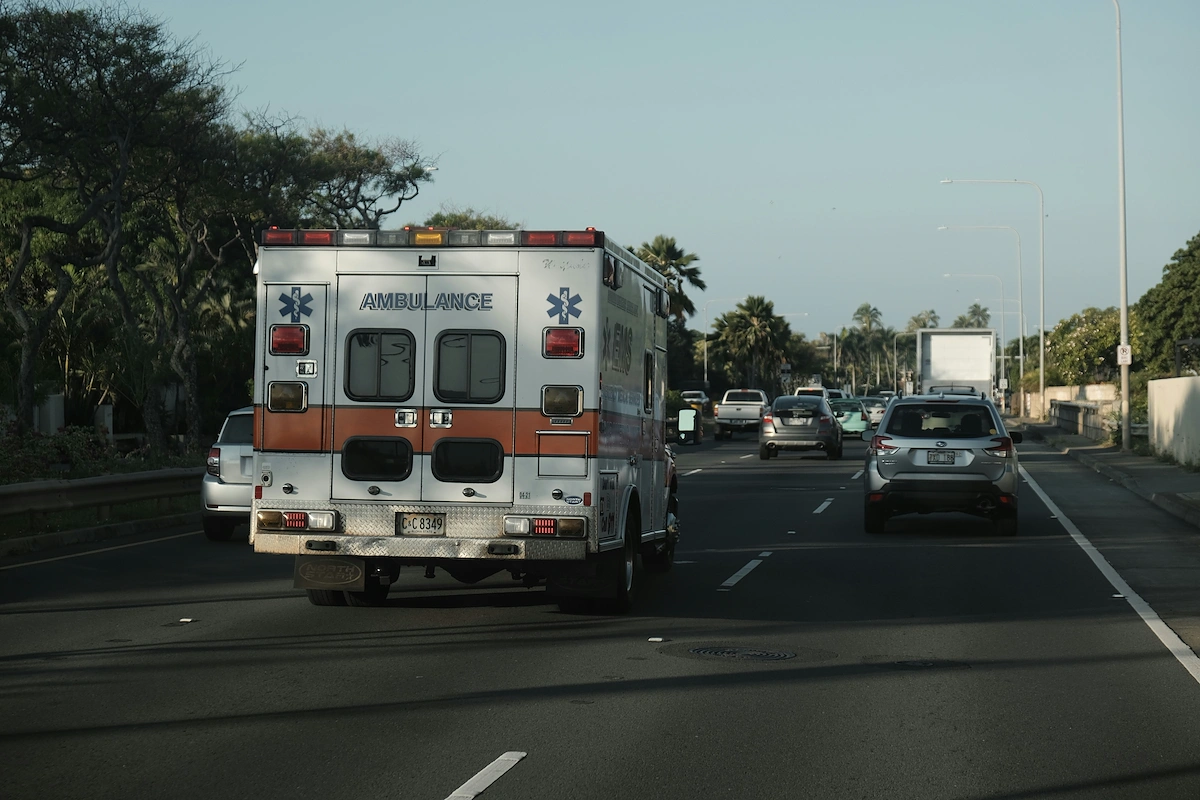Launching a non-emergency medical transportation business can be an incredibly rewarding venture, blending a desire to help people with smart business planning. It's a market worth billions, with consistent demand from seniors, post-surgery patients, and those with chronic conditions who need reliable transport.
This guide will walk you through the practical steps of validating your business concept, obtaining the necessary licenses, acquiring vehicles, and hiring the right staff to help you launch a successful non-emergency medical transportation business in the U.S.
Step 1: Plan and validate your business idea
Gauge local demand
Before spending a dollar, confirm there is a need. Call local hospitals, dialysis centers, and assisted living facilities. Ask their discharge planners or social workers about their current transportation challenges and the volume of patients who require NEMT services.
You can also review demographic data on your county's public health department website to understand the size of the senior population in your target area. A common misstep is buying a vehicle before you have any proof of demand.
Analyze your competition
Next, identify who you are up against. Use Google Maps to find NEMT providers in your desired service area. Also, check your state's Department of Transportation or Public Utility Commission website for a list of licensed carriers. Note their fleet size and service hours.
Estimate your startup costs
Understanding your initial investment is important. Many new owners are surprised by insurance costs, so get quotes early. Here is a typical breakdown to get you started:
- Vehicle: $25,000 - $60,000 for a new or used ADA-compliant van.
- Insurance: $5,000 - $15,000 annually, per vehicle.
- Licensing and Permits: $500 - $2,000.
- Dispatch Software: $100 - $500 per month.
Your total initial outlay will likely fall between $35,000 and $80,000, depending on your vehicle choice and insurance rates.
Here are 3 immediate steps to take:
- Contact three local healthcare facilities to ask about their transportation needs.
- Map all NEMT competitors within a 20-mile radius and list their services.
- Request insurance quotes from at least two agents who specialize in commercial transport.
Step 2: Secure your legal structure and permits
First, form your business entity. Most NEMT owners choose a Limited Liability Company (LLC). This structure separates your personal assets from business debts. You can file for an LLC through your state's Secretary of State website for about $100 to $500.
Navigate federal, state, and local requirements
Your state's Department of Transportation (DOT) or Public Utility Commission (PUC) governs NEMT services. You will need to apply for a state-specific carrier permit, which can cost between $500 and $2,000 and take 60-120 days to process.
Many new operators don't realize that Medicaid brokers often have their own rules. Before you apply for state permits, check the requirements of these brokers. Their insurance and vehicle standards can be stricter than the state's minimums, so confirm them first.
You will also need a standard business license from your city or county. On the federal level, your main concern is ensuring your vehicles comply with the Americans with Disabilities Act (ADA) standards for accessibility, which is a requirement for most contracts.
Here are 3 immediate steps to take:
- File for an LLC with your Secretary of State.
- Identify your state's NEMT regulatory body (DOT or PUC) and download its carrier application.
- Contact a Medicaid transportation broker in your area to get their provider requirements packet.
Step 3: Obtain your insurance and manage risk
Insurance will be a significant part of your budget, so it is smart to tackle it early. Your most important policy is commercial auto liability, as state and broker requirements are strict. Most contracts demand coverage between $1 million and $1.5 million.
Key insurance policies for NEMT
Annual premiums for commercial auto insurance typically range from $8,000 to $15,000 per vehicle. In addition, you will need general liability coverage of at least $1 million to protect against non-vehicle-related incidents, such as a client falling in your office.
If you hire drivers, you must also have workers' compensation insurance. You might also consider professional liability insurance, which covers claims of negligence in your service delivery. Many new operators purchase a policy that fails to meet broker requirements; always confirm coverage amounts before you commit.
To avoid this, work with an agent who specializes in NEMT. Speaking of specialists, you might want to get quotes from providers like National Interstate, Insureon, or Philadelphia Insurance Companies. A general agent may not grasp the unique risks, like patient assistance liability.
Here are 3 immediate steps to take:
- Request quotes from at least two insurance agents who specialize in NEMT.
- Confirm the minimum insurance coverage amounts required by your target Medicaid broker.
- Budget for annual commercial auto premiums between $8,000 and $15,000 per vehicle.
Step 4: Set up your office and acquire equipment
Secure your base of operations
You do not need a large office. A space of 200-400 square feet is usually enough for dispatch and administrative tasks. Check your local zoning laws for "commercial" or "mixed-use" classifications. Some cities permit home-based offices if you do not park commercial vehicles on the property.
When you negotiate a lease, you might want to ask for a shorter term, like one to two years. This gives you flexibility as your business grows. Also, clarify rules about parking your NEMT van overnight, as some commercial landlords prohibit it.
Outfit your vehicle and office
An ADA-compliant van does not always come fully equipped. Many new owners are surprised to find they must purchase safety and accessibility hardware separately. Beyond the vehicle itself, you will need a few items to become operational.
- Wheelchair Securement Systems: $300 - $800 per set. Look at brands like Q'Straint or Sure-Lok.
- Safety Gear: $50 - $150 for a state-compliant first-aid kit and fire extinguisher.
- Communication: Reliable smartphones for drivers are fine to start.
- Uniforms: $50 - $100 per driver for professional polo shirts with your logo.
Uniforms help build trust and present a professional image to both healthcare facilities and clients. It is a small investment that pays off in credibility.
Here are 3 immediate steps to take:
- Check your city's zoning regulations for home-based business and commercial vehicle parking rules.
- Get price quotes for a complete wheelchair securement system from a supplier like Q'Straint.
- Ask a local commercial real estate agent about available 1-2 year leases for small office spaces.
Step 5: Set up your payment processing
Your revenue will likely come from two sources: contracts with facilities and payments from private clients. Facilities like hospitals and nursing homes typically pay via invoice on net 30 or net 60 terms, so you should plan your cash flow around this delay.
Private pay clients, on the other hand, require immediate payment collection. A common oversight for new owners is focusing only on facility contracts. Not having a simple way to accept card payments on the spot can mean lost revenue from individual riders.
For NEMT businesses that need to accept payments on-site or on-the-go, JIM offers a streamlined solution. With JIM, you can accept debit, credit, and digital wallets directly through your smartphone. The process is simple: just tap and done.
At just 1.99% per transaction with no hidden costs or extra hardware needed, it's a very competitive rate. Many other payment solutions charge between 2.5% and 3.5%. This makes it particularly useful for collecting co-pays or full fares from private clients right at the end of a trip.
Getting started is straightforward:
- Get Started: Download JIM app for iOS
- Make a Sale: Type the sales amount, hit sell, and ask your customer to tap their card or device on your phone
- Access Funds: Your money is available right on your JIM card as soon as the sale is done - no waiting for bank transfers
Here are 3 immediate steps to take:
- Decide on your payment policy for private pay clients, such as payment upon booking or completion.
- Download the JIM app to see how it works for on-the-go payments.
- Create a basic invoice template for your facility-based clients.
Step 6: Fund your business and manage finances
Explore your funding options
With your business plan ready, it is time to secure funds. The SBA 7(a) loan is a popular choice for NEMT startups, with amounts often between $30,000 and $150,000. Lenders typically look for a credit score over 680 and will want to see your projections.
You might also consider equipment financing. This is a loan specifically for your vehicle, and the van itself acts as collateral. This can make the approval process smoother. Interest rates for these loans usually fall between 5% and 10%, depending on your credit.
Also, look into grants. The Federal Transit Administration's Section 5310 program gives funds to states to improve transport for seniors and people with disabilities. Check your state's DOT website for details, as these are competitive but worth pursuing.
Plan for your operating cash
Many new owners secure a loan for the van but forget about day-to-day costs. Since facility contracts often pay in 30 to 60 days, you need cash to operate while you wait. A lack of working capital is a frequent reason new NEMT businesses struggle.
You should have at least three to six months of operating expenses in the bank. For a single-van operation, this means having $15,000 to $25,000 set aside for fuel, insurance, driver pay, and software fees before your first invoice gets paid.
Here are 3 immediate steps to take:
- Review the SBA 7(a) loan requirements on the official SBA website.
- Contact your state's Department of Transportation about the Section 5310 grant program.
- Calculate your total monthly expenses and multiply by six to find your working capital target.
Step 7: Hire your team and set up operations
Hire your first driver
Your first hire will likely be a driver. Look for someone with a clean driving record and experience working with seniors or people with disabilities. Pay typically ranges from $15 to $25 per hour. This person is the face of your company, so their professionalism is paramount.
Many new owners focus only on driving skills. You will find that patience and empathy are just as important. Your driver must have certifications in CPR and First Aid. You might also want to look for Passenger Assistance, Safety and Sensitivity (PASS) training, which is an industry standard.
Establish your dispatch process
Once you have a driver, you need a system to manage trips. You can handle dispatch yourself at first. As you grow, you might hire a part-time dispatcher for $18 to $28 per hour. They will manage schedules, communicate with drivers, and handle client calls.
To streamline this, consider NEMT-specific software. Platforms like RouteGenie or MediRoutes help with scheduling, routing, and billing. They often have a monthly fee of $100 to $300. As a benchmark, plan for driver wages to account for 30-40% of your total revenue.
Here are 3 immediate steps to take:
- Draft a job description for an NEMT driver that lists CPR and PASS certifications as requirements.
- Research pricing for NEMT dispatch software like RouteGenie or MediRoutes.
- Check your state's Department of Transportation website for driver background check requirements.
Step 8: Market your business and get clients
Focus on direct outreach
Your first clients will come from relationships. Visit local hospitals, dialysis centers, and assisted living facilities in person. Ask to speak with discharge planners or social workers, as they are the ones who arrange patient transportation.
Arrive with professional business cards and a one-page flyer that lists your services, hours, and contact information. Many new owners make the mistake of just dropping off materials. A face-to-face introduction is far more effective.
With that in mind, persistence is key. Expect to follow up three to five times over two months before a facility sends you a client. Track your visits and conversations in a simple spreadsheet to stay organized.
Build a simple online footprint
While direct outreach is your priority, a basic online presence builds credibility. Create a simple website and a Google Business Profile. This allows facility staff to verify your business after you leave their office.
To encourage a facility to try your service, you might want to offer a discount on their first booking. This lowers their risk and shows confidence in your service quality. It is a proven way to get your foot in the door.
Here are 4 immediate steps to take:
- Create a target list of 15 local healthcare facilities.
- Design and print 250 business cards and 100 one-page service flyers.
- Set up your Google Business Profile with photos and service details.
- Schedule follow-up calls for any contacts you have already made.
Step 9: Set your pricing strategy
Establish your rate structure
Your pricing must be competitive yet profitable. Most NEMT providers use a base rate plus a per-mile fee. For example, you could charge a $25 base fee for the pickup and then add $3.00 for each mile traveled.
You should also account for extra services and wait times. It is standard to add surcharges for wheelchair assistance ($15-$25) or after-hours service ($20). Consider a wait-time fee of $1 per minute after the first 15 minutes.
Calculate your costs and profit
Before setting prices, you must know your cost per mile. Add up your monthly vehicle payment, insurance, fuel, and driver wages, then divide by the miles you expect to drive. This number is your break-even point.
It is tempting to just copy a competitor's rates, but that is a mistake if you have not calculated your own costs. You might end up losing money. Aim for a net profit margin of 20-30% on top of your costs for each trip.
To research your market, call a few local competitors and ask for a quote on a standard 10-mile trip. This gives you a real-world baseline. Then, build your own rate sheet based on your costs and desired profit.
Here are 3 immediate steps to take:
- Call three local NEMT competitors to get quotes for a standard 10-mile trip.
- Calculate your cost per mile by adding all monthly expenses and dividing by projected mileage.
- Create a rate sheet that lists your base fare, per-mile charge, and all potential surcharges.
Step 10: Maintain quality and scale your operations
Establish your quality standards
To ensure consistent service, you should track key performance metrics. Aim for an on-time arrival rate of over 95% and keep client complaints to fewer than 1% of all trips. A simple post-ride text survey can help you gather this feedback.
Many owners overlook formal quality checks until a problem arises. You might want to have all drivers maintain their Passenger Assistance, Safety and Sensitivity (PASS) certification. This is a recognized industry standard that facilities and brokers value.
Know when to grow
Once a vehicle reaches 75-80% utilization, it is time to think about adding another one. This prevents service declines from overbooking. For most single-van operations, this point arrives within 9 to 12 months.
When you consistently manage more than 15 trips per day, a dedicated dispatcher becomes a smart investment. Software like TripMaster or MediRoutes is built for scaling. These platforms can manage multi-vehicle routing and billing far more efficiently than manual methods.
Here are 3 immediate steps to take:
- Calculate your on-time performance rate for the last 30 days.
- Set a vehicle utilization target, like 75%, to trigger your next vehicle purchase plan.
- Review advanced features in software like TripMaster for multi-vehicle fleet management.
You have the steps to launch your NEMT business. Remember, your reputation for reliability and compassion is your greatest asset in this field. The plan is laid out, so you can begin with confidence.
And for your private-pay clients, you will need an easy way to get paid. JIM lets you accept cards on your phone for a simple 1.99% rate, no hardware needed. Download JIM and you are ready for your first fare.















